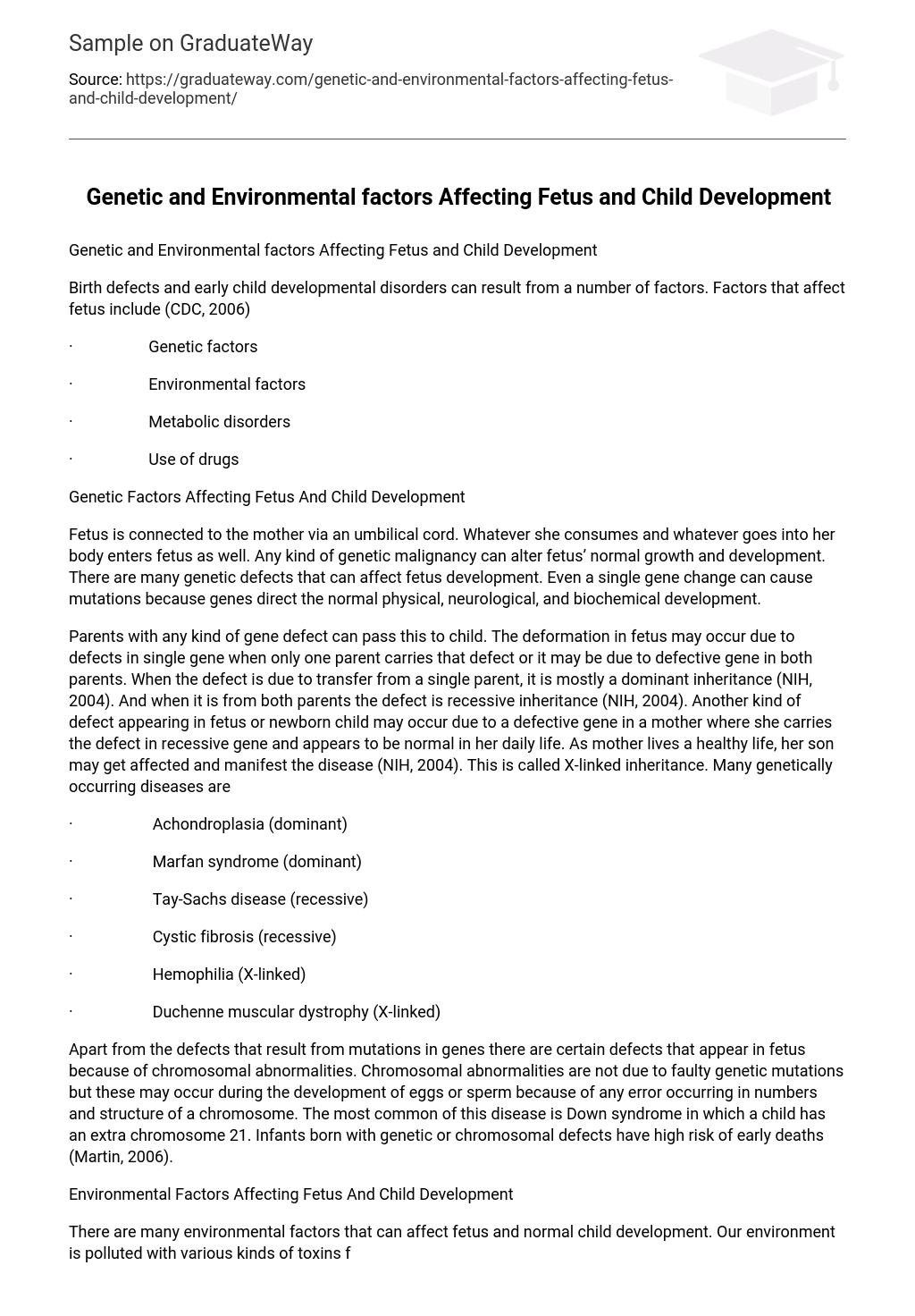Birth defects and early child developmental disorders can result from a number of factors. Factors that affect fetus include (CDC, 2006)
- Genetic factors
- Environmental factors
- Metabolic disorders
- Use of drugs
Genetic factors affecting fetus and child development
Fetus is connected to the mother via an umbilical cord. Whatever she consumes and whatever goes into her body enters fetus as well. Any kind of genetic malignancy can alter fetus’ normal growth and development. There are many genetic defects that can affect fetus development. Even a single gene change can cause mutations because genes direct the normal physical, neurological, and biochemical development.
Parents with any kind of gene defect can pass this to child. The deformation in fetus may occur due to defects in single gene when only one parent carries that defect or it may be due to defective gene in both parents. When the defect is due to transfer from a single parent, it is mostly a dominant inheritance (NIH, 2004). And when it is from both parents the defect is recessive inheritance (NIH, 2004).
Another kind of defect appearing in fetus or newborn child may occur due to a defective gene in a mother where she carries the defect in recessive gene and appears to be normal in her daily life. As mother lives a healthy life, her son may get affected and manifest the disease (NIH, 2004). This is called X-linked inheritance. Many genetically occurring diseases are
- Achondroplasia (dominant)
- Marfan syndrome (dominant)
- Tay-Sachs disease (recessive)
- Cystic fibrosis (recessive)
- Hemophilia (X-linked)
- Duchenne muscular dystrophy (X-linked)
Apart from the defects that result from mutations in genes there are certain defects that appear in fetus because of chromosomal abnormalities. Chromosomal abnormalities are not due to faulty genetic mutations but these may occur during the development of eggs or sperm because of any error occurring in numbers and structure of a chromosome. The most common of this disease is Down syndrome in which a child has an extra chromosome 21. Infants born with genetic or chromosomal defects have high risk of early deaths (Martin, 2006).
Environmental factors affecting fetus and child development
There are many environmental factors that can affect fetus and normal child development. Our environment is polluted with various kinds of toxins from smoke, industrial chemicals and machinery toxics. These are
- Water pollutants
- Air pollutants
- Food contamination
- Lead contamination
- Pesticides
- Polychlorinated Biphenyls
- Methylmercury and Mercury
- Disasters: Natural or Atomic
- Ozone
- Toxic gases like Sulphur dioxide and carbon monoxide
Fetus can be affected by these factors when mother consumes any of the above contaminant either by taking them in her diet (food contamination and water contamination) or by inhaling air polluted with toxins (Environmental Contaminants). Toxic pollutant in air and water can cause many types of deformation in fetus. They can cause abnormal brain development, affect eye development, GIT development or reproductive organs.
Lead is very dangerous type of toxic chemical. It can cause defective brain development in fetus or even mental retardation in developing child. It can also affect eyes, kidneys, heart, and blood cells. It can create psychological problems in child. Mercury or methylmercury if consumed via contaminated water or sea food can cause severe neurological impairment in developing fetus. Other contaminants like sulphur dioxide and carbon monoxide are toxic gases. If inhaled they can affect fetus normal growth and neurological development. Natural disasters like earthquake, cyclones, thunder storms and atomic disasters make the environment polluted with toxic chemicals.
These may cause impairments in development of different parts of fetus. Other toxic chemicals like pesticides (DDT) and PCBs (polychlorinated biphenyls) are also toxic substances present in environment. PCBs are widely used in transformers and hence their presence in environment cannot be avoided. Fetus or developing child when exposed to these substances can have impaired neurological and physical development.
References
- Centers for Disease Control and Prevention (CDC). Birth Defects: Frequently Asked Questions. March 21, 2006.
- Environmental Contaminants and Their Relation to Learning, Behavioral and Developmental Disorders. Retrieved from World Wide Web: http://www.niehs.nih.gov/oc/factsheets/ceh/contamin.htm
- Martin, J.A., et al. Annual Summary of Vital Statistics—2003. Pediatrics, volume 115, number 3, March 2005, pages 619-634.
- National Institutes of Health (NIH). International Human Genome Sequencing Consortium Describes Finished Genome Sequence. NIH News, October 20, 2004.





